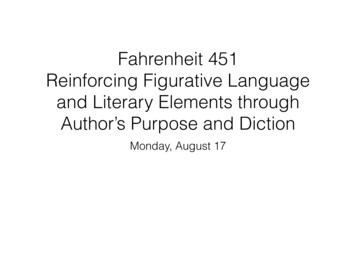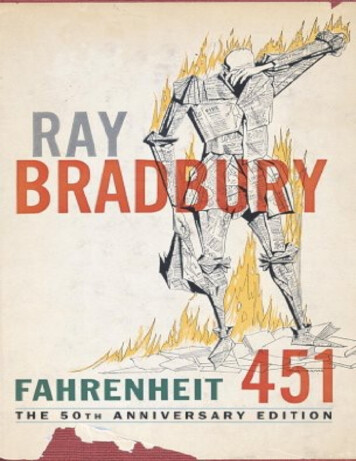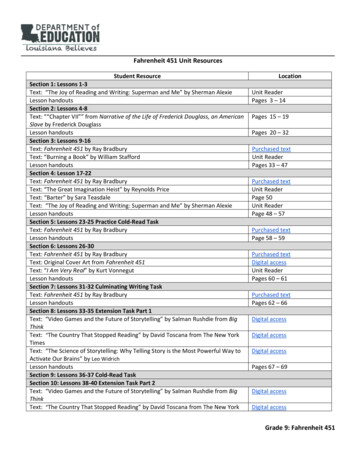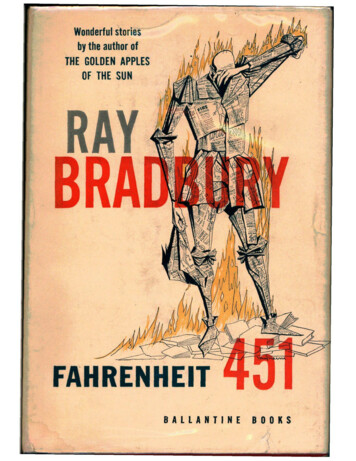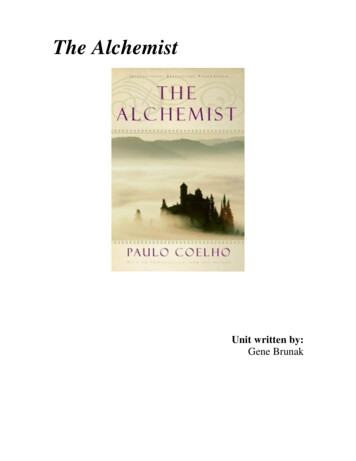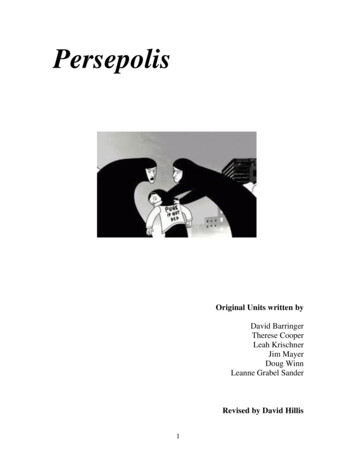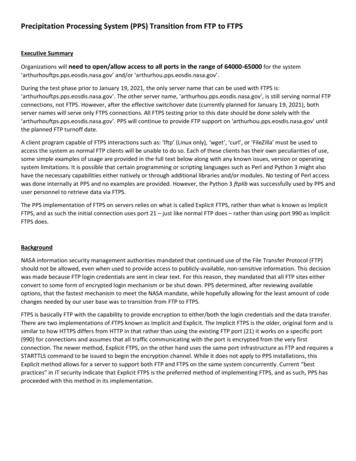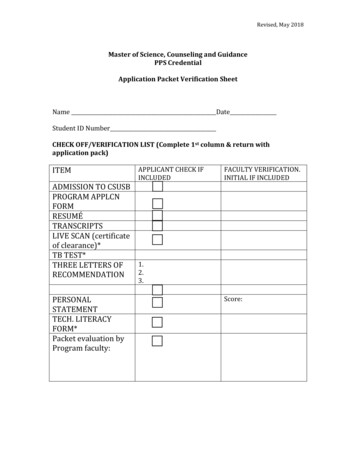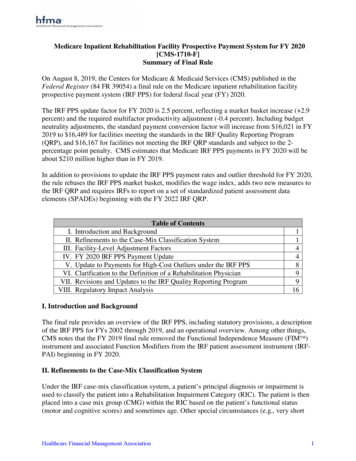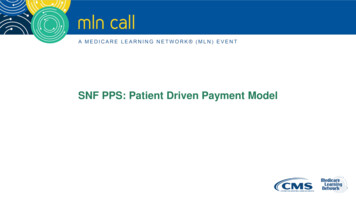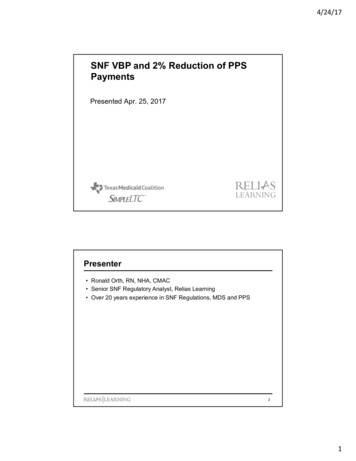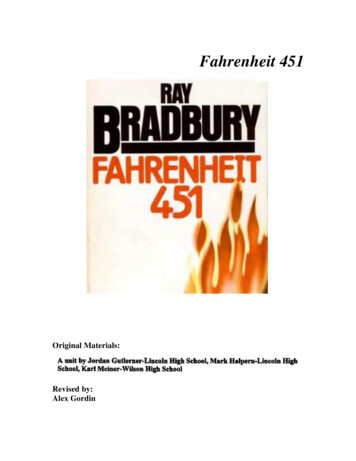
Transcription
Fahrenheit 451Original Materials:Revised by:Alex Gordin
Original Introduction2
A Combustible NarrativeFahrenheit 451 Curriculum Revision“It was a pleasure to burn” (3). Thus begins the dustpan story of a futuristicsociety, Fahrenheit 451 written by Ray Bradbury. This powerful novel andaccompanying curriculum have been designed for the 10th grade level. The unit hasundergone at least three revisions by Portland Public School Language Arts Teachers.This unit, magnanimous in scope, was selected as one of the core units for the 2010-11school year and will be available for sophomore teachers of 10th grade classrooms as partof a pilot project.The special focus on the literary unit was articulated through the creative lens ofGrant Wiggins and Jay McTighe’s, text, Understanding by Design, an innovative set oflearning ideas whose main premise, Backwards Design, is illustrated by the templatecreated at the beginning of this unit. Also, in this set of “deliverables” include a table ofcontents, lessons of the learning plan labeled with academic priority standards, a preassessment, two culminating assessments in student-friendly language, differentiatedpossibilities, and a list of literary terms that have been used in the unit. Finally, aresources section has been added for additional textual selections that may be helpful forthe teacher or student learner. Importantly, the 10th Grade Write Source and the 10thGrade Holt Anthology were extensively referenced to assist the teacher and student in thecomposition of the two possible assessments.Essential questions that provided the impetus for the curricular unit are as follows: How does the story affect individuals in society? How do people engage in social protest? What is the importance of books? What is a theme learned from the text?The culminating assessment and alternative culminating assessments or finalprojects are focused on expository writings. The traditional culminating piece is thethematic essay and the alternative assessment is a research project on a theme thatconnects to today’s society. Consistent with the Backwards by Design model, the largergoals are explored, followed by the specific learning practices that allow the student tocreate and make connections to the text, all, with an organized and punctual format in3
mind. Strategies are specified to allow the student to reflect on the text and review someof the ideas that have been already presented in the classroom.Pre Assessment strategies introduce the student to the culminating project; thewriting process scaffolds and leads to the final writings. Poignantly, there is adifferentiated example of the thematic essay that has been included for students having achallenging time. A Revision and Editing handout has been added to aid the student inwriting process. Connections have been made to the 10th Grade Write Source to provideeasier access to this powerful novel that the Portland Public School System has adopted.Lastly, there is a student reflection designed so that students may review the writing traitsand learning process. The study and written investigation of themes of Fahrenheit 451is not only useful in the classroom but a significant benchmark for thinkers everywhere.4
Fahrenheit 451 TemplateStage 1: Desired OutcomesPriority Standards: (number and description)Reading10.01. Analyze figurative expressions, comparisons and analogies10.07. Draw conclusions about reasons for actions/beliefs and support assertions.Literature10.09:Students will identify the development of themes.10.11: Describe the function and effect upon a literary work of common literary devices suchas symbolism, and irony.10.15: Evaluate how literary elements (conflict, point of view, and setting are used toestablish mood, place, time period, and cultures, and contribute to there development of itstheme.Writing10.16.1: Establish a context where appropriate10.17: Writing Conventions such as roots, bases, prefixes, suffixes, correct use of pronouns.10.18.1: Develop a thesis.10.18.2. Support a position with precise and relevant examples.Optional: Use effective note taking techniques to ensure proper documentation.Understandings:Students will understand that Essential Questions: The narrative elements of the novel.The identification of literary devicesand their effect on the meaning of thestory.How to compose a literary essay. Discuss key episodes, events, and ideasand interpret them on a literal,interpretive, and universal level Students will know: the levels of questioning the story and narrative by RayBradbury. literary elements and particularly focuson figurative language such asmetaphor, simile and symbolism.How does this story affect individualsand society in the 21sst century?How do people engage in socialprotest?What is the importance of literacy insociety?What is the importance of books? Whyread?What is a point or theme learned fromthe story or narrative?Students will be able to: compose a thesis and compose aliterary essay. apply ideas of the text to higherapplications.Stage 2: Assessment EvidenceCulminating AssessmentOther Evidence(learning task)Students may create a brochure on a relatedsocial justice issue around related topics ofbanned books, or a controversial literacy topic.Students will write a literary analysis essay.5
Stage 3: Learning Plan – Fahrenheit 451Activity TitlePriority StandardsLesson #1:EssentialQuestion -What if?Lesson #2: APleasure toBurnLesson #3:Using ActiveNotes10.07. Draw conclusions about reasons foractions/beliefs and support assertions.10.09:Students will identify the development ofthemes.Lesson #4: PreassessmentLesson #5:Burn all, burneverythingLesson #6:Tiered LessonThis OriginalGuideGuide9910.07. Draw conclusions about reasons foractions/beliefs and support assertions.10.09:Students will identify the development ofthemes.10.07. Draw conclusions about reasons foractions/beliefs and support assertions.10.09:Students will identify the development ofthemes.10.11: Describe the function and effect upon aliterary work of common literary devices such assymbolism, and irony.10.15: Evaluate how literary elements (conflict,point of view, and setting are used to establishmood, place, time period, and cultures, andcontribute to there development of its theme.10.07. Draw conclusions about reasons foractions/beliefs and support assertions.10.09:Students will identify the development ofthemes.10.16.1: Establish a context where appropriate10.17: Writing Conventions such as roots, bases,prefixes, suffixes, correct use of pronouns.10.18.1: Develop a thesis.10.18.2. Support a position with precise andrelevant examples.10.07. Draw conclusions about reasons foractions/beliefs and support assertions.10.09:Students will identify the development ofthemes.1112131410.07. Draw conclusions about reasons foractions/beliefs and support assertions.10.09:Students will identify the development ofthemes.10.11: Describe the function and effect upon aliterary work of common literary devices such assymbolism, and irony.10.15: Evaluate how literary elements (conflict,point of view, and setting are used to establish236161926
Activity TitlePriority StandardsThis OriginalGuideGuidemood, place, time period, and cultures, andcontribute to there development of its theme.10.18.1: Develop a thesis.Lesson #7:Motifs10.11: Describe the function and effect upon aliterary work of common literary devices such assymbolism, and irony.10.15: Evaluate how literary elements (conflict,point of view, and setting are used to establishmood, place, time period, and cultures, andcontribute to there development of its theme.34CulminatingAssessment10.09: Identify the development of theme10.16.2: Use organizational structures suchas introduction, body, and conclusion10.16.3: Provide transitions to linkparagraphs.10.18.1: Develop a thesis10.18.2: Support a position with relevantexamples10.16.2: Develop organizational structuressuch as introduction, body, and conclusion3610.16.2: Develop organizational structuressuch as introduction, body, and conclusion4010.16.2: Develop organizational structuressuch as introduction, body, and conclusion4110.18.1:Develop a thesis10.18.2: Support ideas with preciseexamples and documentation10.16: Develop ideas into paragraphs10.16.3: Include transitions10.17: Conventions10.18.2: Support ideas with preciseexamples42Lesson #8:IntroductionLesson #9:BodyLesson on #11:Outline, notecard,informationgatheringLesson #14:Unit ReflectionResources3945Use effective note taking techniques toensure proper documentation.4749752
Academic VocabularyThe vocabulary used extensively in this unit on Fahrenheit sisConnotationDenotation8
Lesson #1: Essential Questions – What if?Overview: This lesson asks students to engage with the idea of speculative literaturelike this novel.9
10
Lesson #2: A Pleasure to BurnOverview: this lesson will introduce students to the close reading approach we willbe taking through the study of this novel.11
The Opening of Fahrenheit 45112
Lesson #3: Using Active NotesOverview: Introduce students to the ways that they will take notes during the study ofthe novel.13
14
15
Lesson #4: Pre-Assessment on the Literary AnalysisOverview: Identify students’ strengths and weaknesses with literary analysis writingDuration: 50 minutesAcademic Priority Standards:10.09: Identify and analyze themes10.13: Evaluate subtleties of the text.10.18: Develop a thesis10.18.2: Support a position with precise and relevant examples.Steps:1. Be sure to explain students about the purpose of a pre-assessment. Its goal is onlyto give the teacher and student a sense of the student’s current abilities withliterary analysis: There will no penalty for not doing well, so long as it iscompleted.2. Hand out the directions and the prompt. Students should write for 30-40 minutesand before submitting, they should fill in the rubric as their own self-assessment.3. When their assessments are returned, be sure that students can take a few minutesto reflect on their own current level with these skills.16
Fahrenheit 451: Pre-assessmentIn this activity, you will write a brief response to the following prompt. You will bescored using the rubric that follows, but the only goal of this assessment is to identifyyour current skill level with literary analysis.Prompt: So far in your reading of the novel, you have come across manyideas that you author probably wants the reader to learn from the novel.Oftentimes, these ideas are called “themes.” What is one major theme oridea that the author puts forward in this novel? Be sure that your responseincludes an introductory paragraph with a thesis, one ore more bodyparagraphs, and a conclusion. Whenever possible, use direct quotes orexamples from the novel to support your position. Proofread your piecebefore submitting.After you complete your response, be sure to assess yourself using the rubric.17
Scoring Guide Pre-Assessment for the thematic free write for Fahrenheit451PriorityStandardExceeds(6-5)Theme is clearlyidentified andthoroughly developedMeets(4-3)Theme is identified,though it may not befully developedthroughout the pieceDoes Not Yet Meet(2-1)Theme has not beenidentified andsufficiently developed10.18.1:Develop athesisWriting has a clearthesis and is developedin the essay.The thesis isappropriate andmostly supported.The thesis statement isunclear, too broad.10.16;Develop ideasintoparagraphsThe organizationpattern works togetherto create an insightfulwriting.The organizationpattern is adequatefor the topic.10.17:ConventionsThe essay has effectivepunctuation andgrammar.There are someerrors in punctuationand grammar.The organizationpattern fits the essay’spurpose. Some partsneed moredevelopment.There are numerouserrors in the writingthat interfere withclarity of the piece.10.09:Identify andanalyze thedevelopmentof themes.After your pre-assessment has been returned by your teacher:1. What do you think you are doing well so far?2. What are you going to focus on improving?18
Lesson #5: Burn all, burn everythingOverview: This is a lesson for students to explore some of the essential questions of thenovel, specifically how and why are books and materials censored.19
20
Letter from Kurt Vonnegut on the burning of his novel:21
22
Lesson #6: Tiered Lesson for Fahrenheit 451Overview: Students will be able to see how the notes they have been takingcan lead to the beginning of a literary analysis essay, while other studentswill be able to get more support or extension depending on their currentneeds.Time: 90 minutesProcedures:1. Looking back on the results of your students’ pre-assessments,arrange them into three groups:a. Group 1: those students who have already met or exceeded allof the standards on the pre-assessment rubricb. Group 2: those met or nearly met all of the standardsc. Group 3: those who did not meet any of the standards.2. Students in group #1 should follow the directions of the lesson thatfollows called “The Vast Wasteland.” Note that you can giveindividual sections of the reading to students; they do not need to readthe whole speech to be able to do the activity. In the time provide,students will be able to have time to read, discuss, and write a briefresponse to the article in the form of an effective thesis statement.3. Students in Group #2 should follow the directions for the lesson titled“Connect the Notes” essay. In the time provided, they will be able toget through step #7 or #8 with their thesis statements.4. Students in Group #3 should follow the steps for the lesson titled“Free Write, List, and Thesis.”5. Debrief the process with students and as an exit ticket, ask them torefl
Fahrenheit 451 Curriculum Revision ³,WZDVDSOHDVXUHWREXUQ 7KXVEHJLQVWKHGXVWSDQVWRU\RIDIXWXULVWLF society, Fahrenheit 451 written by Ray Bradbury. This powerful novel and accompanying curriculum have been designed for the 10 th grade level. The unit has undergone at least three revisions by Portland Public School Language Arts
